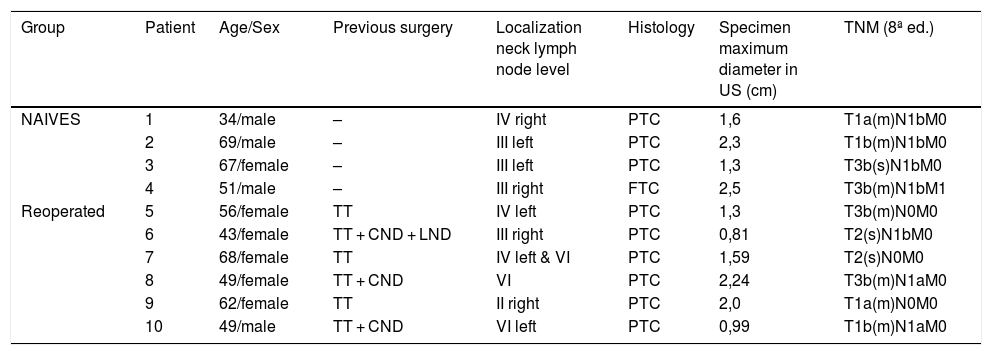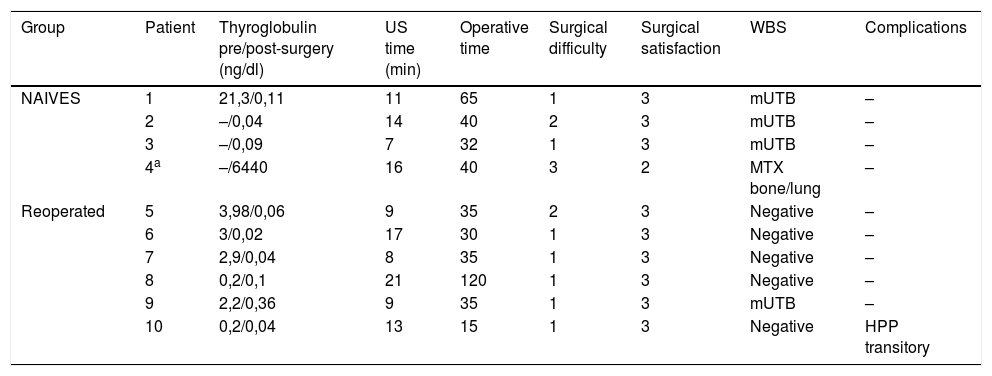The aim of this work is the evaluation of usefulness of radioactive seed localization (RSL) for the detection of cervical recurrence of thyroid cancer in order to improve the surgical outcome.
Material and methodTen patients with thyroid cancer and lymph node involvement (4 naive and 6 with cervical recurrence) evidenced by ultrasound, cytology/Tg-FNAB (reoperated group) were selected for this procedure. A 125I seed was placed in the metastatic lesion using a needle guided by ultrasound. During surgery, a handheld gamma probe/portable gammacamera were used for lesion localization and excision. After removing the target tissue, it was verified that the seed was included in the excised tissue. Surgical intervention duration, lesion location, seed activity, thyroglobulin level, effective radiation dose, complications and the degree of surgical resection were analyzed.
ResultsAll the marked nodes were positive in histology. The mean duration of the ultrasound procedure was 11.4 ± 3.4 min. Seed was kept inside the patient, in average, during 4 days (1–7) and the average surgical time was 44.7 ± 29.1 min. We found 21 metastatic specimens with an average diameter 13.9 ± 6.3 mm. The mean activity of the implanted seed was 71.27 ± 21.6 MBq (42.8–105). In the reoperated group, thyroglobulin level was 2.08 ± 1.56 ng/dl and decreased after surgery to 0.13 ± 0.12 ng/dl, p < 0.01. Only one case of transient hypoparathyroidism was found in the total group.
ConclusionsThe introduction of RSL in our unit has shown benefits for the patient and medical team, being a safe and effective procedure that also improves surgical programming.
El objetivo de este trabajo fue evaluar la utilidad del implante de semillas radiactivas (RSL) para la localización de la recurrencia cervical del cáncer de tiroides.
Material y métododiez pacientes con cáncer de tiroides y compromiso ganglionar (4 de nuevo diagnóstico y 6 reoperados por recurrencia cervical) evidenciados por ultrasonido y citología/Tg-PAAF fueron seleccionados para este procedimiento. Se introdujo una semilla 125I en la lesión metastásica mediante una aguja guiada por ecografía. Durante la cirugía, se utilizaron una sonda/gammacámara portátil para la localización de la lesión. Después de la cirugía se verificó que la semilla estaba incluida en el tejido extirpado. Se analizaron la duración de la intervención quirúrgica, actividad de la semilla, niveles de tiroglobulina, dosis efectiva de radiación, complicaciones y grado de resección quirúrgica.
ResultadosTodos los ganglios marcados fueron positivos en histología. La duración media del procedimiento ecográfico fue de 11,4 ± 3,4 minutos. La semilla permaneció dentro del paciente, una media de 4 días (1–7) y el tiempo quirúrgico medio fue de 44.7 ± 29.1 minutos. Encontramos 21 especímenes metastásicos con un diámetro medio de 13.9 ± 6.3 mm. La actividad media de la semilla implantada fue de 71.27 ± 21.6 MBq (42.8–105). En el grupo reoperado, el nivel de tiroglobulina fue de 2.08 ± 1.56 ng/dl y tras la cirugía 0.13 ± 0.12 ng/dl, p < 0.01. Registramos un caso de hipoparatiroidismo transitorio en el grupo total.
ConclusionesLa introducción de RSL en nuestra unidad ha mostrado beneficios para el paciente y el equipo médico, siendo un procedimiento seguro y efectivo que también mejora la programación quirúrgica.
Article
If you experience access problems, you can contact the SEMNIM Technical Secretariat by email at secretaria.tecnica@semnim.es or by phone at +34 619 594 780.

Revista Española de Medicina Nuclear e Imagen Molecular (English Edition)












